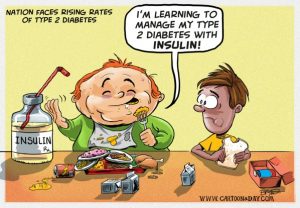Malaysia is recorded as the highest nation in ASEAN of which citizens are diagnosed with diabetes. What is diabetes actually? It is when a person is having abnormally high level of sugar (glucose) in the blood. The problem of diabetes arises when the body produces little or insufficient insulin, the hormone responsible for allowing glucose in the blood to enter body cells for energy production.
Insulin and blood glucose in our body
In normal digestive system, the food taken by a person is converted into glucose (a type of simplified sugar) which is needed by the body cells for growth and energy. Insulin which enables the glucose to be absorbed by the cells is produced in the pancreas (an organ in our body). Every time that we eat, the pancreas helps to produce more insulin to convert blood glucose into energy. Unfortunately, in people with diabetes, glucose cannot be absorbed into their cells because there is inadequate insulin secreted, either because the pancreas is damaged (type 1) or due to resistance to insulin action (type 2). The most common type of diabetes mellitus that are affecting Malaysians are type 2 diabetes mellitus.
Type 2 diabetes mellitus
Type 2 diabetes mellitus normally affects people over the age of 40. The insulin which is produced, however cannot help the glucose to be absorbed by the body cells as the cells are resistant to the insulin action. The resistance to insulin action is frequently related to high body fats. This is also intertwined with obesity as obesity is concerned about people with high body fats. According to New York Times, Malaysia is known as the most obese nation in Southeast Asian. How does the consumed glucose get converted into fats? As Malaysians continue to eat and consume excess sugar and neglecting healthy lifestyle such as exercising, the excess sugars intake will be converted into body fats for long term storage. When there is lack of physical activities the body fats cannot be converted to energy and remain in the body causing a higher body fats or obesity which consequently leads to diabetes mellitus. Below is the statistics on Diabetes in Malaysia based on records by International Diabetes Federation (IDF).
Statistics on Diabetes in 2017
Total adult population: 20,722,000
Prevalence of diabetes in adults: 16.9%
Total cases of diabetes in adults: 3,492,600
Sign and symptoms
The signs and symptoms of diabetes that can be observed are constant tiredness, excessive thirst, frequent urination, especially at night, unexplained weight loss, blurred vision, skin infections and itching in the genital areas, slow healing of cuts and wounds, numbness or burning sensations in the limbs.
Conclusion
Hence, we, Malaysians need to observe our lifestyle. Humans undoubtedly need to eat to generate energy. Nevertheless, as much as we eat, that much exercises also need to be done to avoid high blood sugar and body fats. The younger generation should exercise as well as observe the sugar intake to avoid being a diabetic patient in the later age. The World Health Organisation (WHO) in its campaign against obesity had recommended a sugar consumption limit of 6 teaspoonful daily. Despite the recommendation, we consume 26 teaspoons of sugar daily, making us the eighth highest sugar users in the world. Therefore, we should make a change.
References
- https://www.malaymail.com/news/what-you-think/2016/11/14/unhealthy-living-makes-malaysia-no.-1-in-diabetes-prevalence-in-asean-s-m-m/1249567
- http://www.diabetesmalaysia.com.my/article.php?aid=4
- https://www.idf.org/our-network/regions-members/western-pacific/members/108-malaysia.html
- American Diabetes Association. (2004). Diagnosis and Classification of Diabetes Mellitus. Diabetes Care. 27(1): 1-10.






